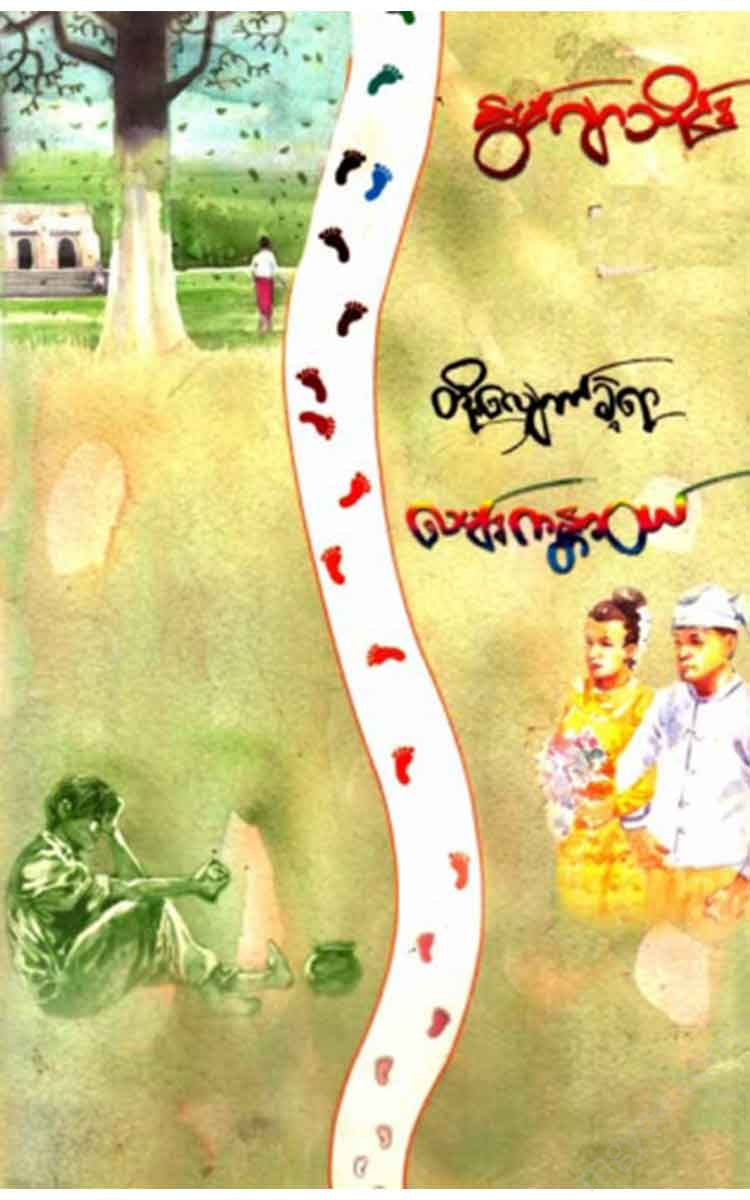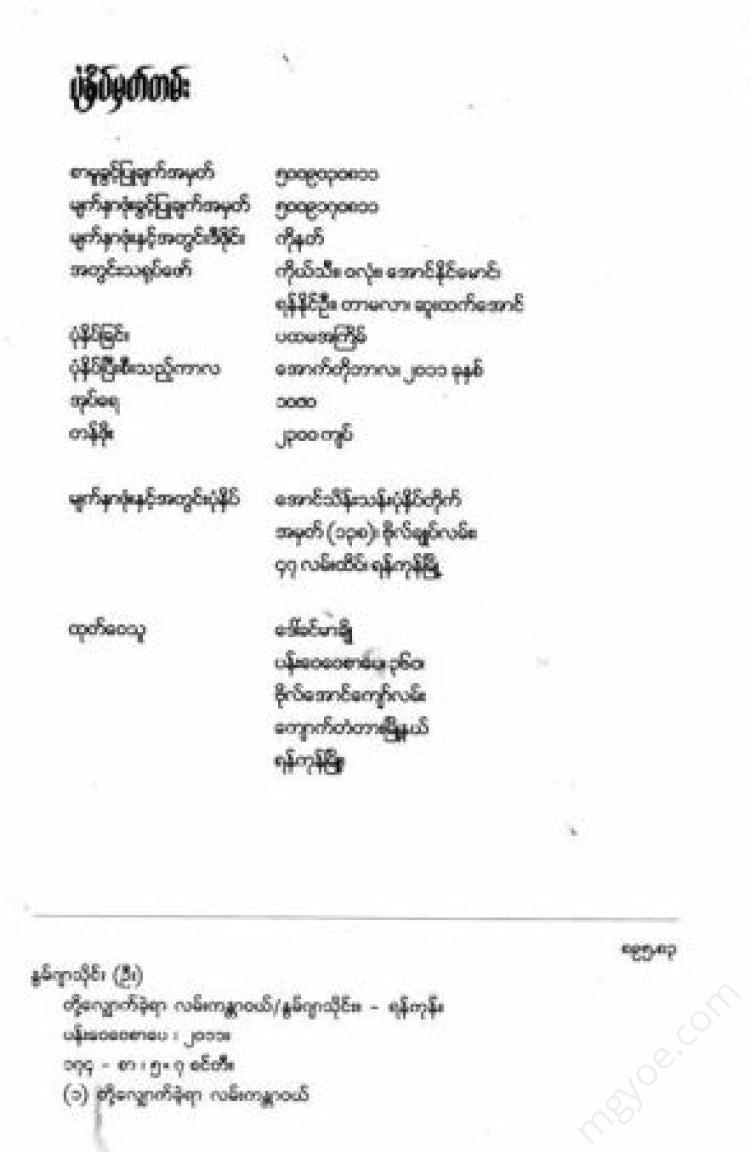Other Websites
Noon Ja Thaing - The Road We Walked Through
Noon Ja Thaing - The Road We Walked Through
Couldn't load pickup availability
I don't remember the first day I learned to walk.
But on that day, everyone around me, except me, will be happy. My grandmother, my mother-in-law, and some of my neighbors who love and support me will be there.
The day I was able to stand, they cheered me on and clapped me, saying, “I can stand = I can stand…” The day I walked, they cheered me on and clapped me, saying, “I can walk - I can walk –'
I don't remember. I'm sure I walked. Because the journey I started that day hasn't ended yet. It's just that. Even though there are no more cheering people saying, "Stop... Stop!", I still keep walking.
"I wish I could write a letter, a poem, a book about the journey you've been through...
Etc... My friends who knew a little bit or a lot about my life often encouraged me. Readers, literary circles, and clubs also said similar things.
But I was still struggling to accept those words, because I could only remember the events, the dates, and the names of the people associated with those events, which were not recorded in my mind.
I am afraid that I cannot give exact dates and details, and that I will not be able to provide full details of the names of those involved, as I would like to disappoint my audience. Similarly, due to my weakness and laziness in writing, I have two great books that I have not written yet, even though I have wanted to write them the most in my life.
The first book is about a long journey of literature and literary lectures that has not ended since 1981 until now (2009). The journeys that have been made in about 300 townships and more than 1,000 events, together with many writers, artists, teachers, some of whom are still alive and some of whom have passed away, are very interesting.
In some conversations, they were very interested when I told them about the experiences of traveling and preaching together with great figures such as U San Htun (Mann University), U Murathakin Chit Maung, and U Yan Aung.
“Please write it down as a letter,” they kept saying. I still haven't complied.
The second book is about a pilgrimage and religious promotion trip I took to four places in Thanvejaniya, including Buddhagaga, around 1985.
The Bodh Gaya Pilgrims' Association organized a trip to record and volunteer for the installation of the Nagarjuna Pagoda (statue) at the Munsalinda Lake (Bodh Gaya) donated by Dr. Aung Than (retired Dean of Dentistry) and Daw Khin May Aye's family. During the trip, I visited the Laila Lama. I saw the work being done while digging the ratha roads in Kolkata. I experienced strange and frightening events at the place (with the National League, Maung Maung Lwin and Ko Hla Myint from the Matpo group, all of which were confirmed by witnesses).
I collected books and documents related to the history, research, travelogues, and other religious buildings and places I visited along the way. I also collected records and pamphlets from the Bagan and Konbaung periods of Burma (from the university library). However, I have not yet written the book I should have written.
I am especially worried about not being able to remember years, dates, dates, and names (related to travel).
Therefore, writing about the journey of life was far from being possible. However, if I had written it, I had chosen the title of that letter, that book, long ago. That title is now the title of this article.
Sayadaw Phyu Kyaw Htun. Few people will have read this poem, "True Love" (originally called "Love Love").
This is a poem that I wrote for the “Flower Festival” poetry book that was compiled and published by my literary friends, Maung Nge Myaing (Myin Chan) and Maung Nge Mon, in Insein around 1970. At that time, I was far away from Sayar Nay Phyu Kyaw Htun (Sayar Kway) and had never even seen him.
At that time, the three of us, along with other friends, formed a small literary circle (our own name) called “Brotherhood and Sisterhood Poetry Wine.”
I would like to rewrite the stories of the poets and writers who worked and moved around literature as much as I could at that time. As far as I can remember, the first time I saw poetry in print was in 1969. I was only 17 years old.
At that time, I was already able to write poetry in four syllables, four syllables, four types of doubles, etc. (at least to rhyme correctly).
I had been practicing my poetry for about three years after reading the series of articles in Saya Jawana's monthly children's journal titled "If You Want to Write Poetry, Write Poetry" by Master Min Thuwan.
If I were to look back on that time, I would say I started writing poetry when I was 14 years old. No, maybe around 12 years old. Because it takes at least two years to write long poems in four lines from the beginning.
The first published poem was called “Kyaw Daeik Sa” and it was a long poem with about 18 lines and 20 verses, so it can be said that I started writing poetry about five years before that. So when did I start to love literature and reading? I don’t remember the exact beginning.
To tell you a few things I remember, my parents and grandmother told me that I was born in Tha Si. However, I don't remember anything about the events in Tha Si, where I only lived for about a year and a half.
I have only been to the house where we lived in Thar Si, the house where I was born, when I was about to get married, when I was over 24 years old, because my mother did not go with me. I have met the host family who loved and cared for me very much when I was young (my mother rented a room in that house).
They didn't know my real name. They only knew the name I was given when I was young, "Khin Maung Oo." They were surprised, "Khin Maung Oo is already this old." When they got there, they learned that the monk had changed my real name to "Win Myint Maung."
When asked to name him “Win Myint,” his mother was adamant, adding a “maung” to the end and saying “Win Myint Maung,” he said he couldn’t. The Buddha said that he had permission.
I am grateful for my mother's modernity. My mother is more modern than that. When I started school, I started at a government primary school. It was a small school not far from my house.
After finishing kindergarten at that school, they did not allow me to continue my studies there for the next grade, but transferred me to St. Joseph's, the most famous English mission school in our town. By that time, we had already arrived in Insein.
Saint Joseph has three years of kindergarten, LK Ki MKGill.K.CG. In those three years, I, who had studied for one year and could keep up with the reading, was assigned to a double I'r> motish class.
I applied today and went to school the next day to ask for a grade reduction, but I couldn't pass the grade and had to repeat kindergarten for three years.
By the time I reached the first grade, I was both old enough to attend school and to be able to learn. | So, my school years were a time when I had never had any serious difficulties in school and wanted to go to a class that I wanted to attend. If you calculate that school years, I would have been over 9 or 10 years old by the time I reached the first grade.
At that time, I could read magazines, newspapers, and modern cartoons, popular cartoons, and cartoon comics.
Another thing I remember is that my grandmother and mother used to buy me books and papers. I also remember reading books like #ສານາກ
The first full-length novel I ever read was “My Land That Remains Green” by Professor Pho Naing. I noticed that the book was published around 1963.
I love literature. One of the reasons for my love of reading is that my grandmother and mother used to scare me when I went out. When I went out to play, I would hit them with a stick from behind, and when I stayed at home, I would study. I would not spare any expense to buy books and read.
The value of books at that time was cheap compared to today's money, but they were valuable in their time.
Linga-ba-sa-sa publications cost 10 kyats, children's journals cost 1 kyat, and comic books cost 60 kyats. At that time, a packet of sticky rice was 5 kyats, a fried rice was 5 kyats, and a bowl of rice cakes was 15 kyats, not fried, and 20 kyats, to compare. My monthly reading expenses were over five kyats.



